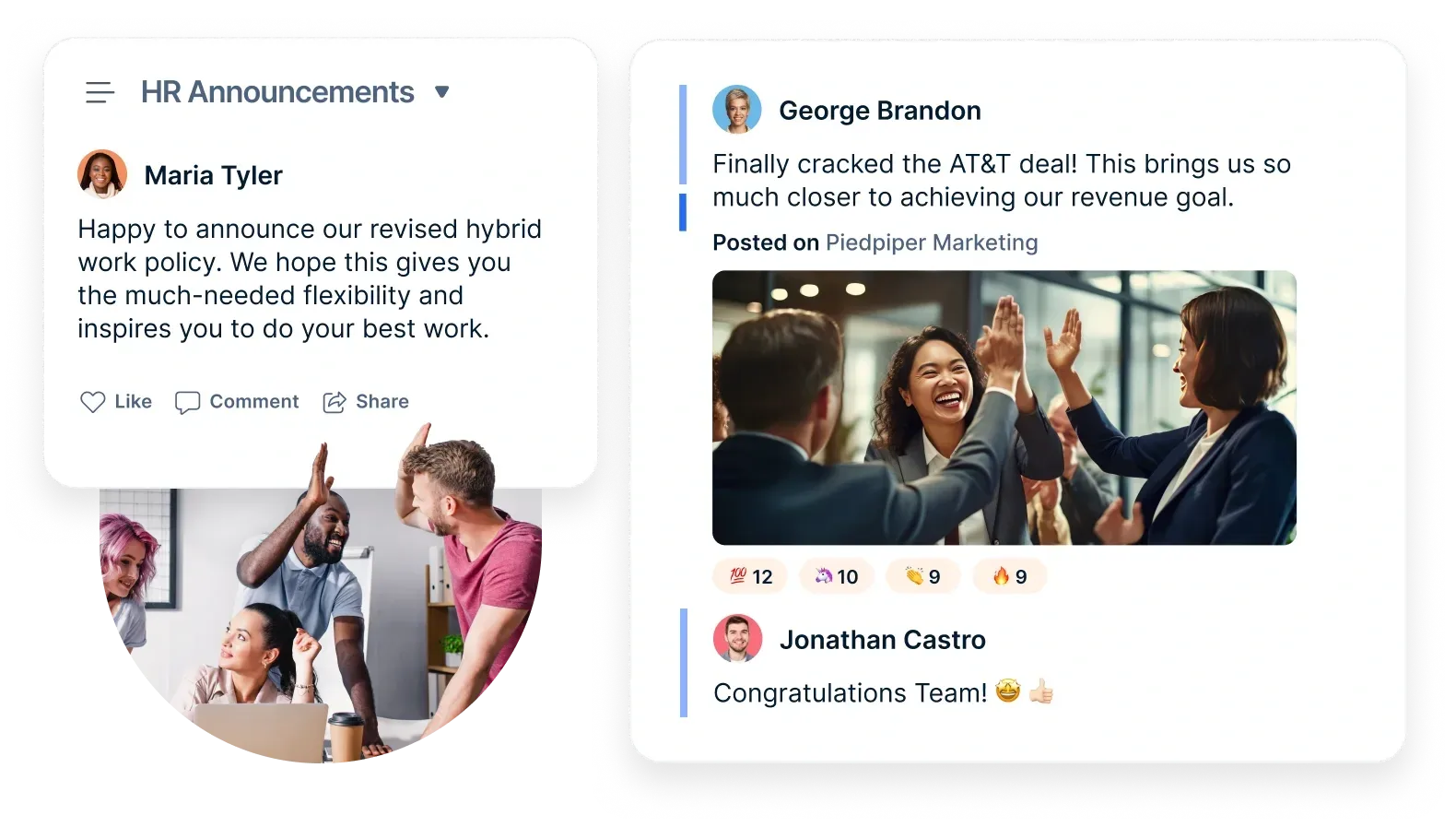On this page
Change is inevitable—but managing it well is a choice. In today’s fast-paced business landscape, organizations must evolve to stay competitive. Whether it’s adopting new technologies, restructuring teams, or redefining strategy, organizational change touches every corner of a business. And yet, despite its necessity, most change efforts fall short. Why? Because change isn’t just about systems or structures—it’s about people.
Organizational change refers to the shifts a company makes to improve performance, respond to market demands, or realign its culture and operations. While the goals are often strategic, the process is deeply human. Fear, confusion, and resistance can quickly derail even the most well-planned initiatives.
That’s why successful change requires more than just a roadmap. It demands clarity, communication, empathy, and a structured approach to guiding people from uncertainty to commitment.
In this blog, we’ll explore what organizational change really involves, the components and strategies that make it work, common pitfalls to avoid, and how platforms like Empuls can help ease the transition by keeping employees informed, aligned, and engaged throughout the journey.
What is meant by organizational change?
Organizational change reshapes a company’s structure, operations, culture, or strategy to adapt and grow. Whether it's a slight shift or a large-scale transformation, it affects people—where it gets tricky.
Driving change is one of the most complex parts of leadership, mainly because people naturally resist it. Around 70% of change initiatives fail, and organizational modifications like customer service transformations see failure rates as high as 93%.
But it doesn’t have to be this way. Many change efforts fail not because they’re impossible—but because they’re made unnecessarily complex or lack clarity. Engagement drops fast when people don’t understand what’s changing, why it matters, or what’s expected of them.
Key areas of organizational change
When organizations evolve, change doesn’t happen in a vacuum. It impacts specific parts of the business that need to shift together in harmony. Leaders must pay close attention to these key areas of organizational change for successful transformation.
1. People
Employees are at the heart of any organization, so changes here can have the most visible impact. This includes talent management, new leadership, team structure changes, or job roles and responsibilities updates. Supporting employees through these transitions with clear communication and empathy is critical.
2. Processes
Processes are the “how” of work. Change here focuses on making operations more efficient, whether it’s how products are developed, services delivered, or internal tasks handled. Streamlining workflows, automating repetitive tasks, or adopting new project management approaches fall into this category.
3. Technology
Introducing new systems—like an HRIS platform, CRM, or cloud-based tools—requires change in how people work and interact with tech. This area also includes training and support to drive adoption, reduce resistance, and ensure a smooth transition.
4. Culture
Culture is often invisible but hugely influential. Shifting from a hierarchical to a collaborative culture, embedding core values, or promoting DEI initiatives are culture-focused changes. These efforts take time but play a decisive role in engagement and performance.
5. Strategy
Strategic changes affect the overall direction of the business—pivoting to new markets, redefining goals, or transforming the customer experience. These require leadership alignment and a strong narrative to rally the organization around a shared vision.
6. Structure
Organizational charts, reporting lines, and team setups all fall under structure. Whether flattening hierarchies or centralizing functions, structural changes impact accountability and collaboration, so they must be handled clearly.
Why change management matters in organizations
Organizational change may be necessary, but without a structured approach to guide it, even the most well-intentioned transformation can fall apart. That’s where change management comes in.
Change management is the discipline that ensures people, processes, and systems transition smoothly from the current state to a desired future state. It’s not just about launching a new tool or policy—it’s about helping people adopt and embrace change in a way that sticks.
But here’s the reality: most change efforts fail, and organizational change is often the most challenging. Why? Because it directly impacts people—and people naturally resist change.
"People are not afraid of hard work; they are afraid of failure."
This insight couldn’t be more accurate. When employees don’t understand the change, its purpose, or their role in it, fear and uncertainty creep in. In fact, up to 70% of change initiatives fail, and customer service-related changes can fail up to 93% of the time. Often, it’s not due to poor strategy—it’s due to a lack of clarity, engagement, and alignment.
Here’s what happens when change management is missing:
- Teams feel left out or confused.
- Leaders struggle to gain buy-in.
- Communication breaks down.
- The change loses momentum halfway through.
And here’s what happens when it’s done right:
- People understand the why behind the change.
- Objectives are clear, measurable, and meaningful.
- Teams feel empowered, not blindsided.
- There’s a structured plan for training, support, and feedback.
Successful change management isn't about avoiding disruption—it's about managing it with purpose, empathy, and precision. It's the bridge that connects organizational ambition with employee readiness.
Components of organizational change management
Behind every successful change initiative lies a solid foundation. These key components of change management determine whether your organizational shift gains traction—or falls flat.
Let’s explore them one by one:
1. Clear objectives
If people don’t know what the change is trying to achieve, how can they support it?
Surprisingly, many change programs launch without well-defined outcomes. One story highlights this perfectly—when even a senior VP couldn’t explain a company’s major change initiative, employees disengaged utterly. Unsurprisingly, the program failed.
A clear objective acts like a compass. It should answer:
- What are we changing?
- What does success look like?
When people can visualize the outcome, they’re more likely to contribute ideas, take initiative, and commit.
2. Clear purpose
A strong “why” fuels commitment. People don’t get behind change just because it’s happening—they engage when they understand why it matters.
Sometimes, the purpose gets lost in corporate jargon. But when it’s communicated with heart, it inspires action. Take the example of a logistics company that reframed its project from "improving delivery KPIs" to "making sure kids get their Christmas gifts on time." That shift in messaging transformed participation and morale overnight.
Leaders must clearly articulate why the change exists—and why it matters to everyone involved.
3. Clear benefits
What’s in it for the people driving the change?
If employees see change as a threat to their roles or security, they’ll naturally resist it. But if they can connect it to growth, new opportunities, or meaningful impact, their mindset shifts.
Make the benefits tangible. Whether it’s upskilling, working on more strategic projects, or simplifying daily workflows—people need to see how the change will improve their world, not just the company’s bottom line.
4. Clear approach
Even the most motivated teams need a roadmap. Change can feel overwhelming without structure.
Breaking the process into clear, manageable steps helps build momentum and confidence. Celebrate early wins, track progress visibly, and show teams how their actions contribute to the bigger picture. This not only reduces fear—it boosts engagement.
5. Clear roles and responsibilities
Change fails when people don’t know what’s expected of them.
Define who does what, by when, and with what support. The more specific you can be about ownership and accountability, the easier teams can act with clarity and confidence.
Whether it’s HR leading the rollout or line managers guiding their teams, everyone should have a role that feels intentional and supported.
These five components—clear objectives, purpose, benefits, approach, and roles—are the building blocks of a successful change initiative. They may seem simple, but they’re often the first things overlooked.
When you get them right, you create empowered, excited teams who don’t just accept change—they drive it forward.
Organizational change management strategies
Organizational change is never just about new strategies or systems. It’s about people, processes, and how everything connects. To navigate this complexity, leaders must understand the core elements of organizational change management—the moving parts that make change possible and sustainable.
Here are the essential elements that bring structure and clarity to change:
1. Leadership alignment
Every successful change begins at the top. Leaders must be on the same page—aligned in purpose, communication, and expectations. If leadership sends mixed signals, employees will sense the disconnect and engagement will suffer.
Strong leadership alignment ensures:
- Consistent messaging across teams
- Faster decision-making
- A united front during uncertainty
2. Communication strategy
Change thrives on communication—not just frequency, but clarity and transparency.
People need to know:
- What’s changing
- Why it matters
- How it affects them
- Where they can go for help
Whether it’s town halls, internal social platforms, or nudges via tools like Empuls, open and continuous communication builds trust and reduces resistance.
3. Stakeholder engagement
Change doesn’t happen in isolation. Stakeholders—from employees and managers to customers and partners—must be actively engaged throughout the process.
That means involving them in early discussions, listening to their feedback, and giving them ownership where possible. When people feel heard, they’re far more likely to support the change.
4. Training and support
Even the best-planned changes fail if people aren’t equipped to adapt. Training ensures that teams have the skills, knowledge, and confidence to embrace the change.
This includes:
- Onboarding for new systems or processes
- Ongoing support through helpdesks or peer mentors
- Resource hubs with FAQs and tutorials
5. Feedback loops and continuous improvement
Change is not a one-time event—it’s a journey. Set up systems to collect feedback, measure adoption, and refine strategies in real time.
Use tools like pulse surveys or employee sentiment analysis to check what’s working and where support is needed. A feedback-driven approach keeps the change dynamic, relevant, and people-centric.
Together, these elements ensure your change management efforts are well-structured and human-first. They help you drive transformation that sticks—because it’s built with, not just for, your people.
Common challenges in organizational change management
Even with a solid strategy, organizational change isn’t easy. The path to transformation is often bumpy, with resistance, confusion, and setbacks. But knowing what challenges to expect—and how to prepare for them—can make all the difference.
Here are some of the most common barriers that derail change efforts:
1. Resistance to change
This is the most predictable challenge. People fear the unknown—especially when it disrupts their routine or job security.
But resistance isn’t always a sign of defiance. Often, it stems from a lack of information, unclear benefits, or previous negative experiences. The solution? Proactive communication, empathy, and inclusion from the start.
2. Lack of clear vision
If employees don’t know what the change is trying to achieve, they can’t support it. One of the stories shared earlier highlights this well—when even senior leaders couldn’t explain a change initiative, it quickly failed.
A clear, compelling vision provides direction and meaning, giving teams something to rally around.
3. Poor communication
Silence or vague updates create uncertainty. People start filling in the gaps with assumptions—which often lean negative.
Change needs consistent, honest communication at every stage. It shouldn’t be one-way; create channels for feedback and dialogue so employees feel like they are part of the journey.
4. No stakeholder buy-in
Change loses traction if key stakeholders—especially middle managers—aren’t on board. They play a critical role in cascading information and driving day-to-day engagement.
Winning their support early and involving them in decision-making helps bridge strategy and execution.
5. Unclear roles and responsibilities
When people don’t know what’s expected of them, things stall. Teams may duplicate efforts or, worse, do nothing at all.
Every change initiative should define who’s doing what, and how success will be measured. This clarity increases accountability and speeds up execution.
6. Underestimating cultural impact
You can change a tool or process overnight—but culture takes time. If the existing culture resists collaboration, transparency, or agility, it can silently sabotage the best change strategies.
Acknowledge the cultural shifts required, and work to build behaviors that support the change over time.
By anticipating and addressing these challenges head-on, organizations can build resilience and trust—two key ingredients for successful change.
How Empuls supports organizational change
Implementing organizational change is as much about people as it is about processes. That’s where Empuls steps in—as a powerful engagement platform designed to connect, align, and motivate teams through change.
Empuls helps organizations manage change more effectively by addressing the human side of transformation. Here’s how:
1. Keep communication transparent and inclusive
With Empuls’ social intranet, you can keep everyone on the same page—sharing updates, celebrating milestones, and opening two-way dialogue across teams. Whether it’s announcing new changes or gathering feedback, Empuls fosters transparency and trust.

2. Listen to your people
Use pulse surveys, eNPS, and lifecycle feedback tools to understand how employees are feeling at every stage of the change journey. Real-time insights help you course correct and ensure change is positively received.

3. Recognize efforts and build momentum
Change is hard work—and recognizing progress matters. Empuls enables peer-to-peer recognition, spot awards, and automated milestone celebrations, ensuring teams feel appreciated and motivated during transition periods.

4. Align everyone to the bigger picture
Through AI-powered nudges and goal-sharing, Empuls helps employees stay aligned with the organization’s evolving objectives and values—ensuring they understand not just what’s changing but why it matters.
5. Drive adoption and participation
Empuls nudges managers and employees to participate in feedback, recognition, and wellness programs—keeping change efforts alive and visible throughout the organization.
Whether you're introducing new tools, shifting culture, or rolling out large-scale transformation, Empuls supports every step by making people feel heard, valued, and connected.
Empuls helps you make that happen.
Conclusion – leading change for long-term success
Organizational change is challenging, but also a chance to grow stronger, smarter, and more aligned.
Success doesn’t come from strategy alone. It comes from clarity, communication, and bringing people along. When teams understand the why, see the benefits, and know what’s expected of them, change becomes less daunting and more empowering.
Lead with purpose, stay transparent, and involve your people every step of the way. That’s how you turn change into progress—and build a culture that’s ready for whatever comes next.















